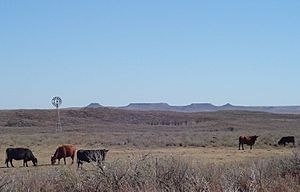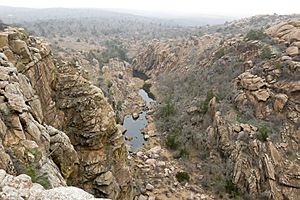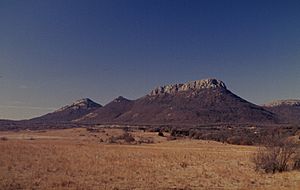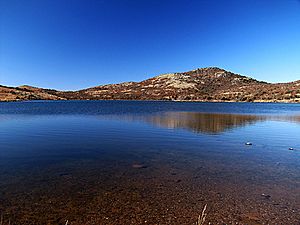Southwestern Oklahoma facts for kids
Southwest Oklahoma is a special part of the state of Oklahoma. It's usually seen as the area south of the Canadian River. This region stretches from the Texas border in the west, eastward to a line that goes through cities like Weatherford, Anadarko, and Duncan.
From a geology point of view, this area was formed by a very old, deep crack in the Earth's crust that didn't fully split apart. It's called the Southern Oklahoma Aulacogen. The landscape here is quite unique, with wide-open prairies and scattered small mountain ranges. This makes it a favorite spot for artists and photographers.
For visitors, the Oklahoma Tourism Department calls this area Great Plains Country. It includes 14 counties: Roger Mills, Custer, Beckham, Washita, Caddo, Kiowa, Greer, Harmon, Jackson, Comanche, Tillman, Cotton, Stephens, and Jefferson.
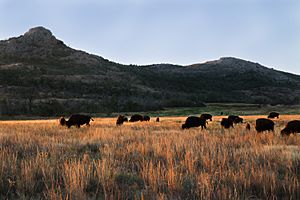
The largest city in Southwest Oklahoma is Lawton. Other important towns include Elk City, Clinton, Weatherford, Walters, Altus, and Duncan.
Contents
History of Southwest Oklahoma
This section explains how the boundaries of Southwest Oklahoma were decided.
Land Disputes and New Territories
In 1890, a law called the Organic Act was passed. Part of this law said that a lawsuit needed to happen to figure out the exact border between Oklahoma and Texas. In 1896, the U.S. Supreme Court decided that some land previously thought to be part of Texas would now belong to Oklahoma Territory. This area makes up the southwestern corner of Oklahoma today. It includes Beckham, Harmon, Jackson, and Greer counties.
Land Runs and Tribal Lands
Another part of Southwest Oklahoma became open for settlement during the Land Run of 1892. Before this, the land belonged to the Cheyenne and Arapaho tribes. After the land run, it became part of Oklahoma Territory. Today, this area includes Blaine, Dewey, Custer, Roger Mills, and Washita counties.
Geography and Landscape
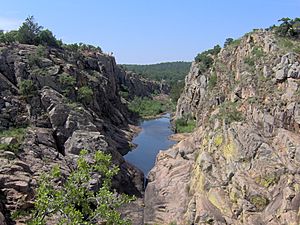
Southwest Oklahoma has grasslands and gently rolling hills. It's a bit different from other parts of the Great Plains region in the United States. It's not as dry as nearby West Texas. Also, it has many unique land features that give it a special climate. The area has a humid subtropical climate. This means it gets a good amount of rain, from about 20 inches in the far west to 35 inches in the eastern part each year. Heavy, monsoon-like rains are common in the spring. However, there can also be dry periods at other times of the year.
Mountain Ranges and Unique Plants
The region has several small mountain ranges that stand out like "sky islands." The biggest of these is the Wichita Mountains. Geologists believe these are some of the oldest mountains in the world.
Southwest Oklahoma is also known for its many rare and special plant species. It's the northern and western limit for plants like the escarpment live oak, nolina, bigtooth maple, and sugar maple.
Important natural landmarks in the region include the Black Kettle National Grassland, the Taovayan Valley, the Wichita Mountains, the Antelope Hills, and the Quartz Mountains.
Climate Patterns
Southwestern Oklahoma has a humid subtropical climate. This means the weather can change often.
The average temperature for Southwest Oklahoma is about 61.9 °F (16.6 °C). In the summer, there are usually about 21 days where temperatures reach 100 °F (37.8 °C) or higher. In winter, the temperature stays below freezing for about eight days on average. The region gets about 31.6 inches (800 mm) of rain each year.
From late April to early June, Southwest Oklahoma can experience severe weather, including tornadoes. For example, in 1957, an F4 tornado hit the southern part of Lawton. Again in 1979, an F3 tornado struck the same area.
Economy and Jobs
The economy of Southwest Oklahoma is mainly based on the United States Armed Forces, farming, manufacturing, and energy. Two military bases are big employers here: Fort Sill in Lawton and Altus Air Force Base near Altus, Oklahoma.
Cattle farming is a very important part of agriculture in the region. Wind farms (which produce electricity from wind) and oil and gas companies also provide many jobs in Southwest Oklahoma.
Education in Southwest Oklahoma
Southwest Oklahoma has both public and private schools for younger students. There are fewer private schools here compared to bigger cities like Oklahoma City and Tulsa.
Public School System
Oklahoma's public school system is well-known for its pre-kindergarten programs. In 2004, the National Institute for Early Education Research ranked Oklahoma's pre-kindergarten education first in the U.S. for its standards, quality, and how easy it was to access. They called it a great example for early childhood education. In the same year, 85.2 percent of adults in Oklahoma had a high school diploma. This was the highest rate among southern states.
Private Schools
Some private schools in Southwest Oklahoma include Western Oklahoma Christian School in Clinton and Corn Bible Academy in Corn.
Colleges and Universities
Cameron University in Lawton is the largest four-year public university in Southwest Oklahoma. It usually has about 6,000 students in the fall.
The region is also home to Southwestern Oklahoma State University, which has campuses in Weatherford and Sayre. In 2011, U.S. News & World Report ranked it highly among "Regional Universities (West)." SWOSU has 15 academic programs that are nationally recognized, which is more than any other similar university in Oklahoma.
The Comanche Nation College in Lawton used to offer two-year programs, but it closed on July 31, 2017.
Southwest Oklahoma also has career training centers like the Great Plains Technology Center and Western Technology Center. These are part of the Oklahoma Department of Career and Technology Education System.


